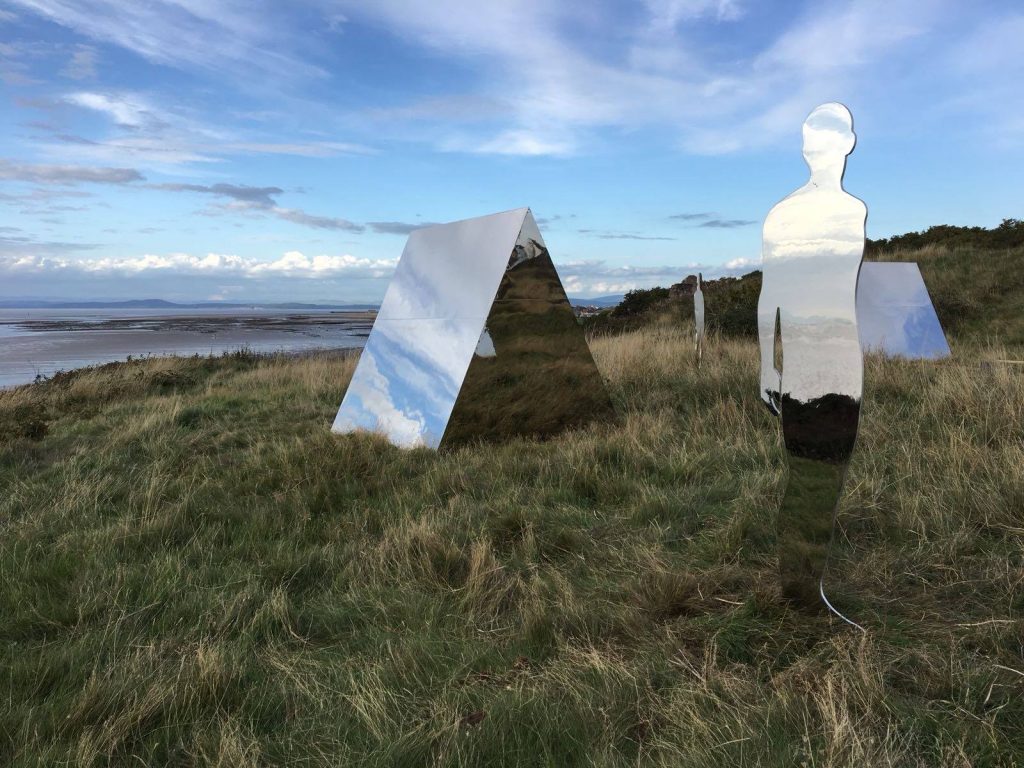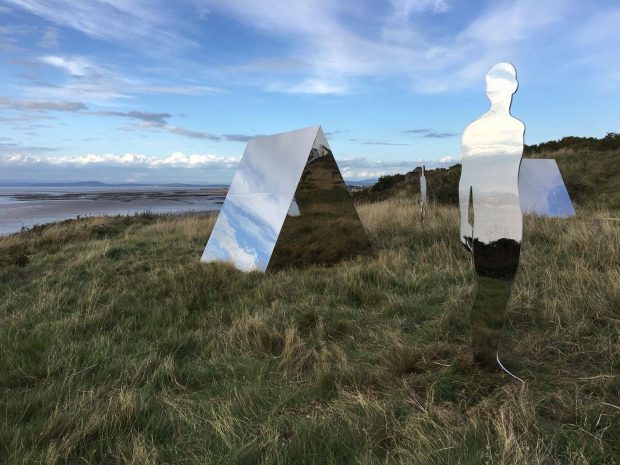
This review was commissioned by Corridor8 and was first published online. For the original review, visit the Corrid0r8 website.
Headlands to Headspace: Landscape Art Commissions
The views from Birkrigg Common are spectacular. Surrounded by limestone pavement and bracken fields, the Common provides a stunning panorama of the rolling Lakeland Fells and the epic coastal landscape of Morecambe Bay. The Bay – the largest intertidal area in the UK – ripples with life and serenity. Its sweeping tides and shifting sands fuel this sense of grandeur. The area’s natural beauty has inspired artists for centuries; it’s easy to see why.
I trekked up Birkrigg Common to visit Rob Mulholland’s installation ‘Settlement’ (2018). It’s the first of five temporary and permanent artworks commissioned by Morecambe Bay Partnership, in partnership with Deco Publique, for the Headlands to Headspace programme, an initiative aiming to celebrate the Bay’s unique heritage. The commissioned artists – Mulholland, Chris Drury, Anna Gillespie, Emily Hennessey and About Time Dance Company – have been invited to creatively respond to the Bay’s rich habitat and history.
Situated next to the Trig point on Birkrigg, devotedly sketched by Alfred Wainwright in his methodical ‘Furness Sketchbook’ (1978), Mulholland’s temporary installation comprised of three stainless steel structures within the landscape, accompanied by six freestanding figures. Their gender is clear. A child stands near a couple; are they a family? Another woman cocks her head to the side, looking out over the Bay. Or is she looking at us? We decide. These ambiguous stainless steel forms reference Anglo-Saxon dwellings while suggesting centuries of human habitation. Every angle offers a new perspective. It’s thrilling to see a sheer expanse of blue – a stolen gap in the clouds – reflected onto the structure; it hits you like a slightly off-colour Yves Klein canvas punctuating the landscape. Nearby, one of the male figures inconspicuously melts into the surrounding bracken and long grass.
The interplay between the work, landscape and viewer was crucial. During my visit on a dreary September afternoon, visitors arrived in droves and engaged from all angles. Any contemporary work featuring a reflective surface is Instabait. ‘Settlement’ was no different; it implored you to whip out your camera for a selfie. A quick scan of the Instagram hashtag #Settlement chronicled beautifully framed photographs of the installation – and the landscape – from many perspectives. To a degree, this was the point. As part of Festival of the Bay, a diverse programme of cultural activities encouraging residents and visitors to engage with the Bay, ‘Settlement’ succeeded in getting people to interact with, and appreciate, their environment in new ways.
Mulholland also asks us to reflect – literally – on how past communities have shaped the Bay and its habitat. For Mulholland, what we see, or glimpse, in the work provides spectral echoes of those who have tread before us; our time here is just as fleeting. One of the male figures caught the low sun, completely dazzling me. It became a white apparition, erased against the vivid Cumbrian landscape; it was striking. Seeing this vision brought to mind the haunting photograph taken minutes before the 1998 Omagh bombing; in an appeal for witnesses, the police later released the image with the people, many of whom died in the atrocity, blanked out.
However, for work ruminating on the impact of humans on the Bay area, there was an odd detachment. Any dialogue between the landscape, sea and past offered little beyond the aesthetic, with its placement at Birkrigg feeling isolated. Beyond their purposeful ambiguity, the structures and figures possessed the cold characteristics of commercial props; it was hard to escape the feeling ‘Settlement’ could exist anywhere. While walking up to Birkrigg Common, I passed a billboard advertising 37.71 hectares of fields for residential building land. This site continually sprang to mind. How would the installation shift if in dialogue with man-made interventions, such as housing, alongside the eternal landscape? Interestingly, several people I spoke to on Birkrigg had also visited ‘Settlement’ when it was first installed the previous fortnight on The Barrows at Heyesham Coast. They all preferred the first iteration, citing its dialogue with the coastline near Heyesham village and the ruins of St Patrick’s Chapel, an Anglo-Saxon monument. More pertinent questions appeared to be raised than at Birkrigg.
Shortly after my visit, the second commission ‘Longways/Crosswise’ (2018) was performed at Gaskell Hall. Choreographed by Jenny Reeves and Ellen Jeffrey, three site-specific outdoor dance performances brought together professional dancers from About Time Dance Company and local participants to reimagine stories inspired by the landscape paintings of David Cox (1783 –1859). Taking place at dusk, the work was immersed within the continuously changing, and often dangerous, environment of the Bay. While the Landscape Art Commissions will present new opportunities to audiences to engage with the landscape in unique ways, it’s also worth remembering the dearth of contemporary galleries and art spaces in the region. My experiences of ‘Settlement’ demonstrated a voracious appetite for art. Looking at Mulholland’s installation, one dog-walker on Birkrigg summarised, “more of this, please.”
Jack Welsh is a freelance arts producer and writer based in Liverpool.
Morecambe Bay Partnership’s Landscape Art Commissions, as part of the Headlands to Headspace Scheme, will take place between July 2018 – March 2019. Please visit www.morecambebay.org.uk for more information.
Image: Settlement (2018), Rob Mulholland – Headlands to Headspace Landscape Art Commissions Morecambe Bay Partnership
